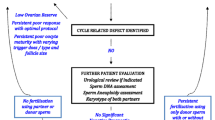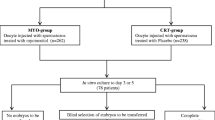Abstract
Objective
Our objective was to determine whether the use of pentoxifylline (PF) would improve the in vitro fertilization (IVF) rate and outcome in couples with male factor infertility and previous failure of fertilization in vitro.
Design
This prospective randomized controlled study was conducted in an assisted conception unit.
Materials and Methods
Forty-nine couples with previous failed fertilization in vitro attributable to male factor or male-factor infertility without previous IVF were recruited for the study. Controlled ovarian hyperstimulation was performed using a combination of gonadotropin releasing hormone agonist and human menopausal gonadotropin. Oocytes of the same grade and maturity were inseminated with spermatozoa treated with PF or control spermatozoa. A maximum of three embryos was replaced after 48 hr and all other embryos were cryopreserved. Pregnancy outcome was followed up and evidence of fetal or neonatal anomalies reported.
Results
A significantly higher fertilization rate occurred in the group where oocytes were inseminated with spermatozoa treated with PF compared with controls (56.3 versus 30.7%; P<0.05). Fertilization occurred in 45 of the 49 cycles (92%). In seven cycles, only the oocytes that were inseminated with spermatozoa treated with PF fertilized, in contrast to only one cycle where the oocytes inseminated with control sperm fertilized (P<0.05). Fifty-seven PF and 31 control embryos were replaced and 11 clinical pregnancies occurred. Three of the pregnancies occurred in the seven cycles in which only PF embryos were replaced, one in the single cycle where control embryos were replaced and seven from the 37 cycles in which both PF and control embryos were replaced. There was no evidence of congenital malformations in any of the offsprings resulting from this study.
Conclusion
This study suggests that PF improves the fertilization rate and outcome in couples with male factor infertility and poor fertilization rates. This study does not suggest any increase in teratogenicity or evidence of congenital malformations in pregnancies following IVF cycles where PF was used.
Similar content being viewed by others
References
Yovich JL: Pentoxifylline: Actions and applications in assisted reproduction. Hum Reprod 1993;8:1786–1791
Hammitt DG, Bedia E, Rogers PR, Syrop CH, Donovan JR, Williamson RA: Comparison of motility stimulants for cryopreserved human semen. Fertil Steril 1989;52:495–502
Rees JM, Ford WCL, Hull MGR: Effect of caffeine and of pentoxifylline on the motility and metabolism of human spermatozoa. J Reprod Fertil 1990;90:147–156
Tesarik J, Thebault A, Testart J: Effect of pentoxifylline on sperm movement characteristics in normozoospermic and asthenozoospermic specimens. Hum Reprod 1992;7:1257–1263
Pang SC, Chan PJ, Lu A: Effects of pentoxifylline on sperm motility and hyperactivation in normozoospermic and normokinetic semen. Fertil Steril 1993;60:336–343
Lewis SEM, Moohan JM, Thompson W: Effects of pentoxifylline on human sperm motility in normospermic individuals using computer-assisted analysis. Fertil Steril 1993;59:418–423
Moohan JM, Winson RML, Lindsay KS: Variability of human sperm response to immediate and prolonged exposure to pentoxifylline. Hum Reprod 1993;8:1696–1700
Tournaye H, Janssens R, Devroey P, Van Steirteghem AC: The influence of pentoxifylline on motility and viability of spermatozoa from normozoospermic semen samples. Int J Androl 1994;17:1–8
Kay VJ, Coutts JRT, Robertson L: Pentoxifylline stimulates hyperactivation in human spermatozoa. Hum Reprod 1993;8:727–731
Mbizvo MT, Johnston RC, Baker GHW: The effect of the motility stimulants, caffeine, pentoxifylline and 2-deoxyadenosine on hyperactivation of cryopreserved human sperm. Fertil Steril 1993;59:1112–1117
Pang SC, Williams DB, Huang T, Wang C: Effect of pentoxifylline on sperm motility and hyperactivated motility in vitro: A preliminary report. Fertil Steril 1993;59:465–467
Tesarik J, Mendoza C, Carreras A: Effects of phosphodiesterase inhibitors caffeine and pentoxifylline on spontaneous and stimulus-induced acrosome reactions in human spermatozoa. Fertil Steril 1992;58:1185–1190
Tasdemir M, Tasemir I, Kodama H, Tanaka T: Pentoxifylline-enhanced acrosome reaction correlates with fertilization in vitro. Hum Reprod 1993;8:2102–2107
Kay VJ, Coutts JRT, Robertson L: Effects of pentoxifylline and progesterone on human sperm capacitation and acrosome reaction. Hum Reprod 1994;9:2318–2323
Das Gupta S, O'Toole C, Mills CL, Fraser LR: Effects of pentoxifylline and progesterone on human sperm capacitation and acrosomal exocytosis. Hum Reprod 1994;9:2103–2104
Yovich JM, Edirishinghe WR, Cummins JM, Yovich JL: Influence of pentoxifylline in severe male factor infertility. Fertil Steril 1990;53:715–722
Imoedemhe DAG, Sigue AB, Pacpaco EA, Olazo AB: Successful use of the sperm motility enhancer 2-deoxyadenosine in previously failed human in vitro fertilization. J Assist Reprod Genet 1992;9:53–56
Tournaye H, Janssens R, Camus M, Staessen C, Devroey P, Van Steirteghem AC: Pentoxifylline is not useful to enhance sperm function in cases with previous in-vitro fertilization failure. Fertil Steril 1993;59:210–215
World Health Organization: WHO Laboratory Manual for the Examination of Human Semen and Semen-Cervical Mucus Interaction, 2nd ed. Cambridge, Press Syndicate of the University of Cambridge. 1987
Veeck LL: Morphological estimation of mature oocytes and their preparation for insemination.In In Vitro Fertilization Norfolk Jones HW, Jones GS, Hodgen GD, Rozenwaks Z (eds). Williams and Wilkins, 1986, pp 81–93
Rizk B, Doyle P, Tan SL, Rainsbury PA, Betts J, Brinsden PR, Edwards RG: Perinatal outcome and congenital malformations in in-vitro fertilization babies from the Bourn Hallam Group. Hum Reprod 1991;6:1259–1264
Tan SL, Doyle P, Campbell S, Rizk B, Brinsden P, Edwards RG: Obstetric outcome of in vitro fertilization pregnancies compared to naturally conceived pregnancy. Am J Obstet Gynecol 1992;167:768–774
Stein DM, Fraser LR: Cyclic nucleotide metabolism in mouse epididymal spermatozoa during capacitation in vitro. Gamete Res 1984;10:283–289
Fraser LR: Adenosine and its analogues, possible activity at A2, stimulate mouse sperm fertilizing ability during early stages of capacitation. J Reprod Fertil 1990;89:469–470
DeJonge CD, Han HL, Lawrie H, Mack SR, Zaneveld LJD: Modulation of the human sperm acrosome reaction by effectors of the adenylate cyclase, cyclic AM second messenger pathway. J Exp Zool 1991;258:113–125
Tournaye H, Wieme P, Janssens R, Verheyen G, Devroey P, Van Steirteghem A: Incubation of spermatozoa from asthenozoo spermic semen samples with pentoxifylline and 2-deoxy adenosine: Variability in hyperactivation and acrosome reaction rates. Hum Reprod 1994;9:2038–2043
Tournaye H, Van der Linden M, Vanden Abul E, Devroey P, Van Steirteghem V: The effect of pentoxifylline on mouse in vitro fertilization and early embryonic development. Hum Reprod 1994;9:1903–1908
Ord T, Mareuo E, Patrizio P, Balmaced JP, Silber SJ, Asch R: The role of laboratory in the handling of the epideolynecol sperm for assisted reproductive technologic. Fertil Steril 1992;57:1103–1106
Lacham Kaplan O, Trounson A: The effects of the sperm motility activators 2-deoxy adenosine and pentoxifylline used for sperm micro-injection on mouse and human embryo development. Hum Reprod 1993;8:945–952
Brinsden PR, Rizk B: The obstetric outcome of assisted conception treatment. Assist Reprod Rev 1992;2:116–125
Author information
Authors and Affiliations
Rights and permissions
About this article
Cite this article
Rizk, B., Fountain, S., Avery, S. et al. Successful use of pentoxifylline in male-factor infertility and previous failure of in vitro fertilization: A prospective randomized study. J Assist Reprod Genet 12, 710–714 (1995). https://doi.org/10.1007/BF02212898
Received:
Accepted:
Issue Date:
DOI: https://doi.org/10.1007/BF02212898




